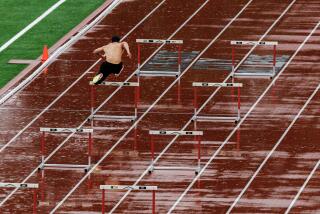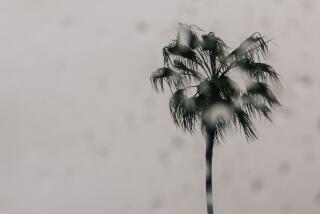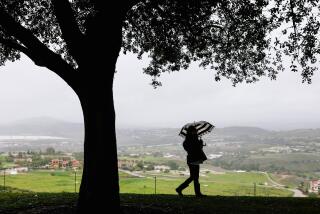Rain Triggers Slides on Denuded Hillsides : Storm: Businesses along Ventura Boulevard scramble to cover quake-damaged walls and roofs with plastic.
Intense downpours from the most powerful storm of the winter lashed the fire-denuded hillsides of Southern California on Monday, loosing mudslides that surged through beachfront houses in Malibu and briefly trapped a dozen residents in Altadena.
Winds gusted to 50 m.p.h. as the main force of the storm marched onshore, rocking outlying areas with thunder claps. A waterspout was reported off Santa Barbara, and cyclonic winds touched down in Sunland and in Orange County.
Commuter traffic--already crippled by earthquake detours--slowed to a crawl in many areas as low-lying intersections flooded and vehicles skidded into one another on rain-slick streets. Officials warned that several major mountain highways--such as those used as detours through the San Gabriels by Santa Clarita and Antelope Valley commuters to bypass quake bottlenecks--probably would be blocked with heavy snow by dawn today.
Cloudbursts drenched work crews laboring around the clock to repair quake-damaged freeways and the battered Cal State Northridge campus. Rain soaked through temporary patches on roofs battered by the Jan. 17 temblor and made life a little more miserable for earthquake refugees still huddled in temporary shelters.
About 3,200 homes lost power for three hours in portions of Sunland, Sun Valley, Granada Hills and North Hollywood.
The potent core of the storm began moving onshore about 2 p.m., and within an hour, hillsides that were stripped bare in last fall’s devastating brush fires began to give way.
In Malibu, water, mud and rocks coursed down canyons to the sea, invading homes and blocking portions of Pacific Coast Highway between Topanga Canyon Boulevard and Malibu Canyon Road.
A delta of debris washed out of Big Rock Canyon Road and across the Pacific Coast Highway, sloshing up against about a dozen houses and scattering half a dozen cars and trucks like sandbox toys.
Homeowners and emergency crews struggled through the muck, trying to erect makeshift dikes with sandbags. But despite their efforts, the mud seeped into the shorefront homes and about 15 houses farther inland at Big Rock and in Las Flores Canyon.
More than 30 residents were forced to evacuate--some of them after being plucked from their roofs, where they had taken refuge from the rising mud and water, in the bucket of a Caltrans skip-loader.
Several people who didn’t want to leave “had to be removed forcibly,” according to Los Angeles County Fire Capt. Scott Smith.
One who left willingly was Greg Powers, whose beachfront house was invaded by tree trunks, uprooted shrubbery and almost four feet of mud and water. Powers said his Jeep was carried away by the torrent that hit his home about 3 p.m.
“I think I might move,” he said. “I’m tired of this. First it was the fires, then the earthquake, now this.”
As Powers surveyed the damage, he carried his two yowling cats around with him in a soggy cardboard pet carrier. “They’re kind of upset,” he said.
In the San Fernando Valley, which bore the brunt of last month’s earthquake, businesses big and small along Ventura Boulevard scrambled to cover damaged walls and roofs with huge sheets of plastic.
One office in a three-story building in Sherman Oaks had been left completely open to the elements, and although workers covered the open area with plastic sheeting, water seeped down through cracks and damaged office supplies.
The supplies were left in “the one part of the suite that we thought would be safe,” said Elsie Bowker, 50, owner of a Sherman Oaks property-management company that once occupied the damaged suite. “We didn’t know that it was the room that the rain would come in.”
Coming so soon after the quake, the storm added “insult to injury,” Bowker commented.
At Century Bank in Encino, it was the timing of the rain that caught bank employees off guard.
“We were somewhat prepared for the rain, but frankly I forgot about one damaged part of the roof, and the rain leaked in there,” said Albert Sage, a Century vice president. Sage estimated the storm would add $10,000 to the $250,000 damage the bank suffered in the earthquake.
About 3,200 customers in North Hollywood, Granada Hills, Sun Valley and Sunland were left in the dark when the rains and wind knocked out five main circuits in the area. Service was largely restored by about 9 p.m.
Winds described by witnesses as “cyclonic” knocked down trees and electrical lines in Sun Valley, leaving traffic signals and a train crossing gate without power. An area just north of the Burbank Airport was particularly hard hit.
At about 3:40 p.m., Crockett Street resident Sandra Morales heard a loud thud outside her home. “I looked out the window and there was garbage in the air, but I didn’t see my car,” said Morales, 23.
“When I went outside, I saw the tree was lying on my car.”
Nearby, at the busy intersection of San Fernando Road and Sunland Boulevard, a sign broke off the El Mexicano Taco Stand, shattering in the street. The windows of the drive-in stand also blew out.
“The glass shattered and went into the food,” said cook Max Alcaraz, 17. “But we just heated up more and kept it going.”
Throughout the Valley, the rain overwhelmed storm drains, creating small rivers that slowed traffic on many boulevards.
Above Malibu, basketball-sized rocks crashed down onto Old Topanga Canyon Road, and sheets of mud and gravel covered stretches of the pavement. The persistent rains were beginning to warp wooden signs erected to thank firefighters for their efforts during the hellish fires that burned through Topanga Canyon last fall.
Sharon Sandler returned from work Monday night to find her Malibu house filled with four feet of mud.
“The bedroom has been washed away into the ocean,” she said. “It was like a river running through it.”
The muck spilled off her back porch like a waterfall, splattering down into storm-driven waves that swirled around the pilings supporting her home. Although some of the sand around the pilings was washing away, all the homes appeared to be standing fast Monday night.
“The same thing happened” more than 20 years ago, said neighbor Monique Marti, who said she probably would spend the night with friends in Santa Monica. “But you hate to go away from your home,” she said. “Because you don’t know what it will look like when you get back.”
Vera Smith slogged her way to safety after her Mercedes-Benz was trapped in a mudflow near Big Rock Drive.
“As I looked to make the next curve, there was this huge bank of mud coming toward me,” she told a KABC-TV crew. “Unbelievable, unbelievable. Things you see in the movies--and it was happening to me.”
In Altadena, mud, rocks and debris from about 600 acres burned in last fall’s fire slid down onto Pasadena Glen Road during a short but intensive cloudburst, isolating about 20 hillside homes and damaging some of them. Most of the residents had already fled or were away at work, but about a dozen were cut off from escape as the mudslides continued to threaten their houses.
After about an hour, county firefighters slogged through mud up to four feet deep to reach the stranded people and escort them to safety. There were no reports of injuries.
The Altadena slide cut another street, Old Grove Road, but the residents there were able to use alternate routes.
In Orange County, cyclonic winds touched down near an industrial area and carved a swath to UC Irvine, blowing down trees and power lines, shattering windows and damaging a roof, police and fire officials said.
Laguna Beach hillsides ravaged in the Oct. 27 fire were holding up pretty well, according to Bill Reiter, public works operations manager for the county’s Environmental Management Agency.
Reiter’s office was coordinating the efforts of about 50 workers--including 24 prison inmates--on hand to monitor the situation and help shore up the hillsides in case of mudslides.
Curtis Brack, a meteorologist with WeatherData Inc., said the heavy rain should have tapered off well before dawn today, with a few showers--and possibly some more thundershowers--predicted until about noon.
“There should be partial clearing by the afternoon as the storm system continues moving inland,” he said. “After that, it looks like it should be pretty dry for the rest of the week.”
By 5 p.m. Monday, 0.51 of an inch of rain had fallen at the Los Angeles Civic Center, raising the total for the season to 3.21 inches. The normal season’s total for Feb. 7 is 8.61 inches. By this time last year, the city had received 18.83 inches.
Other rainfall totals as of 5 p.m. Monday included 1.73 inches in Santa Barbara, 1.58 in Long Beach, 1.30 in Santa Ana, 1.01 at Los Angeles International Airport, 0.88 in Palm Springs, 0.71 in Newport Beach, 0.63 in Monrovia, 0.41 in San Diego and 0.08 in Bakersfield.
Times staff writers Kathleen Kelleher, Mike Carlson, Nieson Himmel, Shawn Hubler, Bob Pool, Miguel Bustillo and correspondent Jeannette Regalado contributed to this story.
More to Read
Sign up for Essential California
The most important California stories and recommendations in your inbox every morning.
You may occasionally receive promotional content from the Los Angeles Times.











